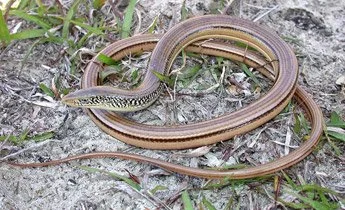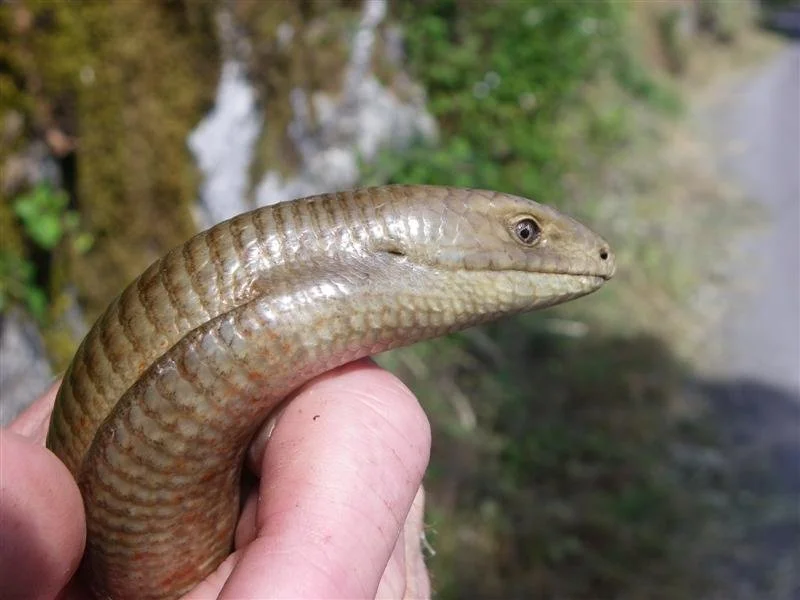A Legless Lizard Does Not A Snake Make…






It’s a worm! It’s a snake! It’s a… lizard with no legs? Meet glass lizards!
What is it? This is a legitimate question, because isn’t a snake just a legless reptile? Well, yes, but there are distinct differences between glass lizards and snakes. First, let’s look at their heads. All lizards, including glass lizards, have eyelids, whereas snakes do not. So, if the “snake” blinked at you… that’s a glass lizard. Moving on, glass lizards have a little ear hole behind their eyes. Snakes can’t hear anything—they sense vibrations to detect what’s nearby. Glass lizards do not have flexible jaws like a snake and definitely cannot unhinge them. Lastly, glass lizards have a small groove running down the side of the body. This is called… wait for it… a lateral groove. I know, very original. So in short, glass lizards = lizards without legs. Hope that helps! Oh, and one last thing: glass lizards are not the only family of legless lizards (I know, crazy).
Where in the world do they live? Like Carmen Sandiego, glass lizards are found all across the globe. They tend to live in grasslands or forests and enjoy hiding in leaf debris, grass, soil, and other safe places. Being reptiles, glass lizards live in warmer climates since they cannot regulate their own body temperature (aka ectotherms). They are commonly found in the southern parts of Europe and Asia, the northern part of Africa, and the southeastern part of North America.
What do they eat? Glass lizards mainly eat a wide variety of invertebrates like insects and spiders, but they’ve also been known to eat smaller reptiles and even a young rat or two. They are handy to have living around your house.
What does reptile romance look like? When a boy glass lizard meets a girl glass lizard, and they like each other very much… nope, different story, sorry. After some digging, I found that, in the spring, boy meets girl, they do the deed, and then go their separate ways. Super romantic, I know. The female glass lizard will then find a safe place, like under a fallen tree, to lay her eggs (around 5-17) and will tend to them for about 2 months. The babies can take care of themselves after hatching, which is nice for mama. Glass lizards reach sexual maturity around 2 years old.
What is the glass lizard’s superpower? In my opinion, they have a solid 1.25 superpowers. I give them 0.25 just for being a lizard with no legs—I mean, that’s so cool and odd, and I love it. Bravo! The main superpower is hinted at in their name: “glass.” They earned this name because they can drop their tail to escape predators. Many lizards can do this, but glass lizard tails can “shatter” into multiple pieces, hence the name. There were myths that all these pieces would come back together and reattach, but sadly, that’s not true. However, they can grow a new tail—it just takes time. I’m giving them 0.75 superpower points for regrowing their tail, bringing the total to two superpowers!
How many glass lizards are there? Get ready for this… there are 15 different species of glass lizard! I’ll list the species in the science section. As a side note, closely related slowworms belong to the same family and have five species, though they aren’t called glass lizards. I just didn’t want them to feel excluded.
Science Time!
Alright here’s the breakdown of species in each genus
Dopasia - Found in Asia
Buettikofer’s glass lizard, Dopasia buettikoferi
Burmese glass lizard, Dopasia gracilis
Hainan glass lizard, Dopasia hainanensis
Hart’s glass lizard, Dopasia harti
Ludovic’s glass lizard, Dopasia ludovici
Sokolov’s glass lizard, Dopasia sokolovi
Wegner’s glass lizard, Dopasia wegneri
Hyalosaurus - Found in North Africa
Koelliker’s glass lizard, Hyalosaurus koellikeri
Ophisaurus - Found in North America
Slender glass lizard, Ophisaurus attenuatus
Ceron’s glass lizard, Ophisaurus ceroni
Island glass lizard, Ophisaurus compressus
Plain-neck glass lizard, Ophisaurus incomptus
Mimic glass lizard, Ophisaurus mimicus
Eastern glass lizard, Ophisaurus ventralis
Pseudopus - Found in Europe
Sheltopusik aka Pallas’s glass lizard or European glass lizard, Pseudopus apodus
According to the IUCN Red List, the glass lizards are categorized as of least concern except the Plain-neck glass lizard, which is data deficient. Meaning more surveying and research needs to be conducted to get an accurate count. Threats to glass lizards include the loss of habitat due to urban and commercial development, roads, and wood related industry.
Resources:
Balkan, J. (2021). Six legless lizards. Reptiles Magazine. https://reptilesmagazine.com/six-legless-lizards/
Hammerson, G. (2007). Ophisaurus mimicus. The IUCN Red List of Threatened Species 2007: e.T63720A12709987. https://dx.doi.org/10.2305/IUCN.UK.2007.RLTS.T63720A12709987.en.
SREL Herpetology. (n.d.). Island Glass Lizard (ophisaurus compressus). Species Profile. https://srelherp.uga.edu/lizards/ophcom.htm
